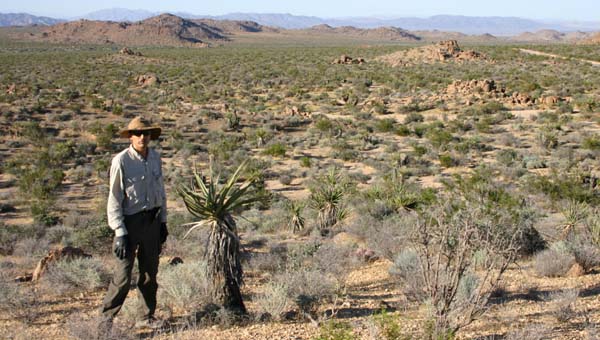
I visited Joshua Tree National Park on the first day I arrived in California, Feb. 11, 2004. A few days ago, I revisited the park. Unfortunately, several of the inner-park roads were closed so I could not reach some of the more scenic areas. However, the road closures (as well as the hot, summer desert weather) had one nice effect: the park seemed devoid of tourists. In fact, I saw no one else during my entire visit, which is very unusual (but desirable!). It was as if I had the whole park to myself! Being very thin (calorie restricted), I was able to cope with the heat quite well, even with full-covering sun-protective clothing, a heat-retaining hat, and gloves. (below) 2005-08-29: This 135-degree panorama -- comprised of 15 separate 55 mm images -- was captured from JTNP, about 2.5 miles North of Cottonwood Visitor's Center. Although, technically, this area of JTNP is a "high-desert" valley (rougly 2,500 - 3,000-feet above sea level), it is still contained in the lower of the two major desert systems -- Colorado (generally, below 3000 ft) and Mojave (generally, above 3000 ft) -- represented in this park. The Colorado Desert is a subdivision of the Sonoran desert found in the southwestern United States and northern Mexico. A section of the Colorado Desert can be seen in the image below. The Colorado Desert lies at a lower elevation than the Mojave, generally less than 3000 feet, and receives a great deal less moisture. It is also warmer and freezing temperatures are rare. The Colorado Desert contains fewer plants and presents a much drier appearance as can be seen below. |
<----
Scroll this image left to right to see all ---->

| (below) 2005-08-29: Wide-angle image, taken from approximately the same south-west vantage point in panorama above. |
(below) 2005-08-29: Wide-angle
image, taken from approximately the same North-facing vantage point in panorama
above. The plants which live in the
Colorado Desert, such as the yucca next to me, must be capable of surviving
with very little water.

The following information was extracted from the U.S. Department of the Interior -- National Park Service web site:
Joshua Tree National Park consists of nearly 800,000 acres set aside to protect the unique assembly of natural resources brought together by the junction of three of California’s ecosystems. The Colorado Desert, a western extension of the vast Sonoran Desert, occupies the southern and eastern parts of the park. It is characterized by stands of spike-like ocotillo plants and “jumping” cholla cactus. The southern boundary of the Mojave Desert reaches across the northern part of the park. It is the habitat of the park's namesake: the Joshua tree. Extensive stands of this peculiar looking plant are found in the western half of the park. Joshua Tree's third ecosystem is located in the western most part of the park above 4000 feet. The Little San Bernardino Mountains provide habitat for a community of California juniper and pinyon pine.
The plant diversity of these three ecosystems is matched by the animal diversity, including healthy herds of desert bighorn and six species of rattlesnakes. Joshua Tree National Park lies astride the Pacific flyway of migratory birds, and is a rest stop for many. It was for this unusual diversity of plants and animals that Joshua Tree National Monument was set aside on August 10, 1936.
The park also encompasses some of the most interesting geologic features found in California’s desert areas. Exposed granite monoliths and rugged canyons testify to the tectonic and erosional forces that shaped this land. Washes, playas, alluvial fans, bajadas, desert varnish, igneous and metamorphic rocks interact to form a pattern of stark beauty and ever changing complexity.
For more information on Joshua Tree National Park, visit the official web site.
Technical:
All images taken with Canon Digital Rebel 300 EOS camera. Focus: manual. All other parameters: manual. Tripod was used.